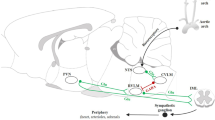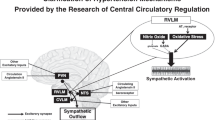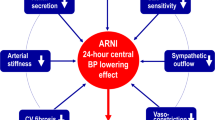Abstract
Biochemical, physiological and functional studies suggest that the brain renin-angiotensin system (RAS) is regulated independently of the peripheral RAS. The classical actions of angiotensin II in the brain include blood pressure control, drinking behaviour, natriuresis and the release of vasopressin into the circulation. At least two subtypes of G-protein coupled receptors, the AT1 and the AT2 receptor, have been identified. Most of the classic actions of angiotensin II in the brain are mediated by AT1 receptors. The AT2 receptor is involved in brain development and neuronal regeneration and protection. Additionally, AT2 receptors can modulate some of the classic angiotensin II actions in the brain. Selective non-peptide AT1 receptor blockers, applied systemically, have been shown to inhibit both peripheral and brain AT1receptors. In genetically hypertensive rats, inhibition of brain AT1 receptors may contribute to the blood pressure lowering effects of AT1 receptor blockers. Animal studies have shown that AT1 receptor antagonists enable endogenous angiotensin II to stimulate neuronal regeneration via activation of AT2 receptors. In animal models, inhibition of the brain RAS proved to be beneficial with respect to stroke incidence and outcome. Blockade of brain and cerebrovascular AT1 receptors by AT1 receptor blockers prevents the reduction in blood flow during brain ischaemia, reduces the volume of ischaemic injury and improves neurological outcome after brain ischaemia. This paper reviews the actions of angiotensin II and its receptors in the brain, and discusses the possible consequences of AT1 receptor blockade in neuroprotection, neuroregeneration, cerebral haemodynamics and ischaemia.
This is a preview of subscription content, access via your institution
Access options
Subscribe to this journal
Receive 12 digital issues and online access to articles
$119.00 per year
only $9.92 per issue
Buy this article
- Purchase on Springer Link
- Instant access to full article PDF
Prices may be subject to local taxes which are calculated during checkout


Similar content being viewed by others
References
Unger T . The angiotensin type 2 receptor: variations on an enigmatic theme J Hypertens 1999 17: 1775–1786
Lucius R et al. Beyond blood pressure: new roles for angiotensin II Cell Mol Life Sci 1999 56: 1008–1019
Unger T et al. Brain angiotensin: pathways and pharmacology Circulation 1988 77 (Suppl I): 1–40
Saavedra JM . Brain and pituitary angiotensin Endocr Rev 1992 13: 329–380
Saye JA, Ragsdale V, Carey RM, Peach MJ . Localization of angiotensin peptide-forming enzymes of 3T3-F442A adipocytes Am J Physiol 1993 264: C1570–C1576
Phillips MI, Sumners C . Angiotensin II in central nervous system physiology Regul Peptides 1998 78: 1–11
Culman J et al. Angiotensin as neuromodulator/neurotransmitter in central control of body fluid and electrolyte homoeostasis Clin Exp Hypertens 1995 17: 281–293
Ganten D, Lang RE, Lehmann E, Unger T . Brainangiotensin: on the way to becoming a well studied neuropeptide system Biochem Pharmacol 1984 33: 3523–3528
Lind RW, Swanson LW, Ganten D . Organization of angiotensin II immunoreative cells and fibers in the rat central nervous system Neuroendocrinology 1985 40: 2–24
De Gasparo M et al. International union of Pharmacology. XXIII. The angiotensin II receptors Pharmacol Rev 2000 52: 415–472
Blume A, Herdegen T, Unger T . Angiotensin peptides and inducible transcription factors J Mol Med 1999 77: 339–357
Vauquelin G, Fierens F, Verheijen I, Vanderheyden P . Insurmountable AT1 receptor antagonism: the need for different antagonist binding states of the receptor Trends Pharmacol Sci 2001 22: 343–344
Gyurko R, Wielbo D, Phillips MI . Antisense inhibition of AT1 receptor mRNA and angiotensinogen mRNA in the brain of spontaneously hypertensive rats reduces hypertension of neurogenic origin Regul Peptides 1993 49: 167–174
Culman J et al. Effects of systemic treatment with irbesartan and losartan on central responses toangiotensin II in conscious, normotensive rats Eur JPharmacol 1999 367: 255–265
Gohlke P et al. AT1 receptor antagonist telmisartan administered peripherally inhibits central responses to angiotensin II in conscious rats J Pharmacol Exp Ther 2001 298: 62–70
Gohlke P et al. Effects of orally applied candesartan cilexetil on central responses to angiotensin II in conscious rats J Hypertens 2002 20: 1–10
Nishimura Y, Ito T, Hoe K-L, Saavedra J . Chronic peripheral administration of the angiotensin II AT1 receptor antagonist Candesartan blocks brain AT1 receptors Brain Res 2000 871: 29–38
Unger T et al. Differential effects of central angiotensin II and substance P on sympathetic nerve activity in conscious rats Circ Res 1985 56: 563–575
Lenkei Z, Palkovits M, Corvol P, Lorens-Cortès C . Expression of angiotensin type-1 (AT1) and type-2 (AT2) receptor mRNAs in the adult rat brain: afunctional neuroanatomical review FrontiersNeuroendocrinol 1997 18: 383–439
Veltmar A et al. Involvement of adrenergic and angiotensinergic receptors in the paraventricular nucleus in the angiotensin II-induced vasopressin release JPharmacol Exp Ther 1992 262: 1253–1260
Lowes VL, McLean LE, Kasting NW, Ferguson AW . Cardiovascular consequence of microinjection of vasopressin and angiotensin II in the area postrema Am J Physiol 1993 262: R625–R631
Muratami H et al. Brain angiotensin and circulatory control Clin Exp Pharmacol Physiol 1996 23: 458–464
Chalmers J et al. Central neurons and neurotransmitters in the control of blood pressure Clin ExpPharmacol Physiol 1994 21: 819–829
Head GA . Role of AT1 receptors in the central control of sympathetic vasomotor function Clin ExpPharmacol Physiol 1996 Suppl 3: S93–S98
Dampney RAL, Hirooka Y, Potts PD, Head GA . Functions of angiotensin peptides in the rostral ventrolateral medulla Clin Exp Pharmacol Physiol 1996 Suppl 3: S105–S111
Allen AM et al. AT1-receptors in the central nervous system JRAAS 2001 2 (Suppl 1): S95–S101
DePasquale MJ, Fossa AA, Holt WF, Mangiapane ML . Central DuP 753 does not lower blood pressure in spontaneously hypertensive rats Hypertension 1992 19: 668–671
Bunting MW, Widdop RE . Lack of centrally-mediated antihypertensive effect following acute or chroniccentral treatment with AT1-receptor antagonists inspontaneously hypertensive rats Br J Pharmacol 1995 116: 3181–3190
Kamitani A et al. The effects of central administration of angiotensin II type-1 receptor antagonist, CV-22974, in nephrectomized spontaneously hypertensive rats Clin Exp Pharmacol Physiol 1994 21: 271–276
Nakamura S et al. Activation of brain angiotensin system by in vivo human angiotensin-converting enzyme gene transfer in rats Hypertension 1999 34: 302–308
Paton JFR, Kasparov S . Sensory channel specific modulation in the nucleus of the solitary tract JAutonom Nerv System 2000 80: 117–129
Gallinat S et al. Sciatic nerve transection evokes lasting up-regulation of angiotensin AT2 and AT1 receptor mRNA in adult rat dorsal root ganglia and sciatic nerves Mol Brain Res 1998 57: 111–122
Lucius R et al. The angiotensin II type 2 (AT2) receptor promotes axonal regeneration in the optic nerve of adult rats J Exp Med 1998 188: 661–670
von Lutterotti N et al. Angiotensin II receptor antagonist delays renal damage and stroke in salt-loaded Dahl salt-sensitive rats J Hypertens 1992 10: 949–957
Stier CT Jr, Adler LA, Levien S, Chandler PN . Stroke prevention by losartan in stroke-prone spontaneously hypertensive rats J Hypertens 1993 11 (Suppl): 537–542
Werner C et al. Captopril improves neurologic outcome from incomplete cerebral ischemia in rats Stroke 1991 22: 910–914
Sadoshima S et al. Angiotensin converting enzyme inhibitors attenuate ischemic brain metabolism in hypertensive rats Stroke 1993 24: 1561–1567
Paulson OB et al. Role of angiotensin in autoregulation of cerebral blood flow Circulation 1988 77: I55–I58
Vraamark T, Waldemar G, Strandgaard S, Paulson OB . Angiotensin receptor antagonist CV-11974 and cerebral blood flow autoregulation J Hypertens 1995 13: 755–761
Inada Y et al. Protective effects of candesartan cilexetil (TCV-116) against stroke, kidney dysfunction and cardiac hypertrophy in stroke-prone spontaneously hypertensive rats Clin Exp Hypertens 1997 19: 1079–1099
Nishimura Y, Ito T, Saavedra JM . Angiotensin II AT1 blockade normalizes cerebrovascular autoregulation and reduces cerebral ischemia in spontaneously hypertensive rats Stroke 2000 31: 2478–2486
Saavedra JM, Ito T, Nishimura Y . The role of angiotensin II AT1 receptors in the regulation of the central blood flow and brain ischaemia JRAAS 2001 2 (Suppl 1): S102–S109
Dai W-J et al. Blockade of central angiotensin AT1 improves neurological outcome and reduces expression of AP-1 transcription factors after focal brain cerebral ischemia in rats Stroke 1999 30: 2391–2399
Dirnagl U, Iadecola C, Moskowitz MA . Pathobiologyof ischaemic stroke: an integrated review TrendsNeurosci 1999 22: 391–397
Author information
Authors and Affiliations
Corresponding author
Rights and permissions
About this article
Cite this article
Culman, J., Blume, A., Gohlke, P. et al. The renin-angiotensin system in the brain: possible therapeutic implications for AT1-receptor blockers. J Hum Hypertens 16 (Suppl 3), S64–S70 (2002). https://doi.org/10.1038/sj.jhh.1001442
Published:
Issue Date:
DOI: https://doi.org/10.1038/sj.jhh.1001442
Keywords
This article is cited by
-
AT 1 inhibition mediated neuroprotection after experimental traumatic brain injury is dependent on neutrophils in male mice
Scientific Reports (2023)
-
Possible repair mechanisms of renin-angiotensin system inhibitors, matrix metalloproteinase-9 inhibitors and protein hormones on methamphetamine-induced neurotoxicity
Molecular Biology Reports (2021)
-
Drug repositioning and repurposing for Alzheimer disease
Nature Reviews Neurology (2020)
-
Angiotensin-converting enzyme insertion/deletion gene polymorphism in multiple sclerosis: a meta-analysis
Neurological Sciences (2016)
-
Protective Effect of Aliskiren in Experimental Ischemic Stroke: Up-Regulated p-PI3K, p-AKT, Bcl-2 Expression, Attenuated Bax Expression
Neurochemical Research (2016)



